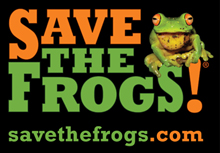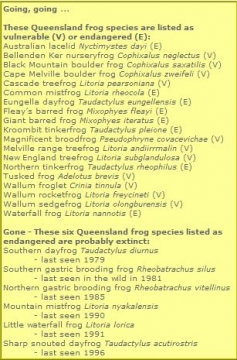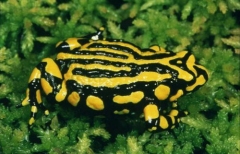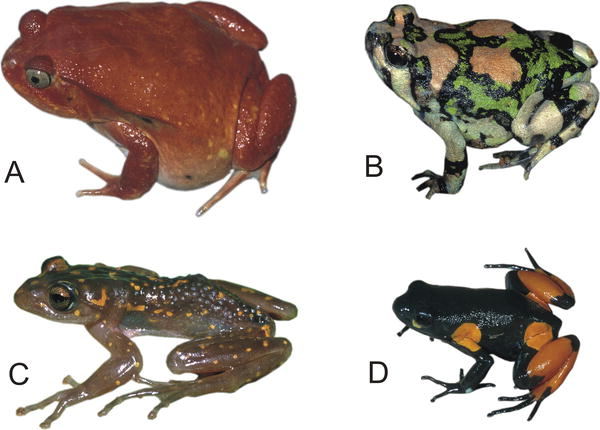
Logan and Albert Conservation Association

 SAVE THE FROGS! is an international team of scientists, educators, policymakers and naturalists dedicated to protecting the world's amphibian species: the frogs, toads, newts, salamanders, and caecilians.
SAVE THE FROGS! is an international team of scientists, educators, policymakers and naturalists dedicated to protecting the world's amphibian species: the frogs, toads, newts, salamanders, and caecilians.
Frogs are going extinct NOW - worldwide - in Australia and locally in our area in South east Queeensland. The rapid loss and disappearance of amphibian populations in recent decades is undoubtedly one of the most tragic losses of biodiversity our society has ever witnessed, and is one of the most serious environmental issues of our time. Loss of biodiversity has far reaching implications.
We can all help by reducing our individual impact on the planet, by sharing our concern with others, and by making our politicians, our representatives in government aware of our concerns.
One very useful action - of benefit to human health as well as other species is to avoid the use of toxic pesticides. From the forum we read that pesticides and herbicides are toxic chemicals that generally undergo little to no testing on amphibians prior to their being approved for use. Unfortunately, the law of gravity has it that many of these pesticides end up in waterways, where amphibians live and breed. To make matters worse, amphibians have permeable skin that is highly absorbent.
 Wildlife Queensland reports that Queensland has 124 species of frog, more than any other Australian state. Within the coastal region 48% of Queensland's frog species live below 100m altitude. They are the species most threatened by habitat loss and degradation.
Wildlife Queensland reports that Queensland has 124 species of frog, more than any other Australian state. Within the coastal region 48% of Queensland's frog species live below 100m altitude. They are the species most threatened by habitat loss and degradation. Currently, 25 Queensland frog species are listed as vulnerable to extinction or endangered, but this list is growing - 6 of these species may already be extinct.
Locally at Jerry's Downfall we have habitat and home for the vulnerable Wallum frogs.
The threats
1. Habitat loss
Frogs need native vegetation but they are losing their habitat through Land clearing and urbanisation, industry and associated infrastructure, especially in coastal south-east Queensland.and Intensive agriculture.
2. Habitat degradation
Frogs and tadpoles need clean water to breed and grow. Water bodies are becoming less suitable for frogs because:
Pollution, including nutrients, runs off from lawns, gardens and agriculture.
Pesticides, especially in urban areas, are toxic to frogs.
Weeds from agriculture are taking over frog-friendly wet forests and altering water chemistry.
Changes in stream and wetland hydrology make wetlands [ the habitat of the wallum sedgefrog] unsuitable for frog breeding.
Development is disturbing acid sulphate soils, which upsets the water's pH balance.
3. Global warming
Reduced rainfall and increased temperatures will affect frog species.
Rising sea levels might affect frogs in coastal areas, for example, the wallum sedgefrog
4. Disease
An introduced fungal disease is killing upland rainforest frogs as well as affecting more common species like the green tree frog. Even apparently common species like the green treefrog (Litoria caerulia) are threatened by exotic diseases.
5. Exotic fish
Mosquito fish (Gambusia holbrooki), introduced to control mosquito larvae, eat frogspawn and tadpoles.
Aquarium fish and other exotics are a threat to frogs if released into to the wild.
What you can do
Conserve frog habitats along streams, gullies and rivers.
Conserve wetlands, especially seasonally flooded areas and ephemeral wetlands - such as melaleuca swamps.
Never let soaps, detergents or pesticides flow into stormwater drains or waterways.
Create frog-friendly gardens by encouraging naturally occurring trees, shrubs and ground covers.
Lobby local and State governments to value and protect native vegetation, particularly creekside and low-lying areas.
Lobby local and State governments to control development including managing stormwater runoff and retaining native vegetation.
Reduce your own greenhouse gas emissions that contribute to global warming.
Reduce the spread of disease among amphibian populations by not moving frogs and tadpoles from one place to another.
Prevent the spread of exotic and aquarium fish into waterways.

Although the Corroboree Frog is not a species found in our local biodiversity, all plans for its recovery and survival are applauded by us.
Efforts to save one of Australia's most recognisable frogs, the Corroboree Frog, from extinction were boosted with the launch of the Corroboree Frog Conservation Trust Fund.
Minister for the Environment, Heritage and the Arts, Peter Garrett, officially launched the Trust at the Wonga Wetlands Education Centre on the Murray River near Albury.
Many Australians know Corroboree Frogs by their bright yellow and black markings. Sadly, the Corroboree Frog is seriously threatened with extinction and preservation efforts are at a critical stage.
 Much of PNG's forests remain unexplored, and have been kept in pristine condition thanks to the care of the local tribes who inhabit them.
Much of PNG's forests remain unexplored, and have been kept in pristine condition thanks to the care of the local tribes who inhabit them.
"Their intimate knowledge of and stewardship over a large tract of this vast upland wilderness has led to conservation of their wildlife and environment," said Bruce Beehler from Conservation International.
The tribes rely on the wilderness for hunting as well as gathering forest products, and the region provides fresh drinking water to thousands of people living in the Enga Southern Highlands as well as Western and Saudaun provinces.
Click on the frog image to see other photos on National Geographic website and read about those species. Uniquely adapted to their habitat, females lay their eggs underneath river stones, and tadpoles have mouths that can suction onto slippery rocks.
Other new species include jumping spiders, a striped gecko, and a tiny chirping frog. More than 600 species, old and new, were documented during the expedition into the vast Kaijende uplands, one of the Papua New Guinea's largest mountainous wilderness areas. The forests also are significantly critical as they absorb large amounts of the greenhouse gas carbon dioxide, and this absorbsion helps with slowing global warming.
However, deforestation has been occuring and is reported in this National Geographical story. Satellite images from 1998 and 2008 depict this clearly and according to a study of three decades of satellite imagery 8 million hectares of forest were lost between 1972 and 2002.
Species
This recovery plan is a multi-species plan for wallum-dependent frog species of coastal south-east Queensland and eastern New South Wales. The species covered by this plan are the wallum sedgefrog Litoria olongburensis, Cooloola sedgefrog L. cooloolensis, wallum rocketfrog L. freycineti and wallum froglet Crinia tinnula.
Current species status
The species in this plan are listed as ‘Rare' or ‘Vulnerable' under state legislation, the Queensland Nature Conservation Act 1992 and the New South Wales Threatened Species Conservation Act 1995. However, only the wallum sedgefrog is listed under the Commonwealth Environment Protection and Biodiversity Conservation Act 1999 (EPBC Act). All species in this plan are listed as ‘Vulnerable' or ‘Endangered' by the World Conservation Union (IUCN).
Habitat and distribution
The species in this plan are wholly or largely restricted to lowland sand plains, dunes and sand islands of coastal south-east Queensland and New South Wales (including coastal ‘wallum'). All breed in oligotrophic (nutrient poor) acidic (pH < 6.0) coastal swamps and/or lakes.
Threats
The species in this plan have suffered significant habitat loss due to urban and resort development, the establishment of pine plantations and sand mining. Habitat loss and fragmentation due to urban development remains one of the main threats to wallum frog species, particularly in coastal south-east Queensland and northeast New South Wales. Other known and potential threats include habitat degradation, predation of eggs and larvae by introduced fish (in particular the mosquito fish Gambusia holbrooki), inappropriate fire regimes, use of biocides in weed and mosquito control, habitat disturbance and predation by pigs, chytrid fungus infection, a possible rise in sea levels as a consequence of global warming, competition with ecologically-similar species, exotic disease and vehicular traffic.
 With nearly one-third of amphibian species threatened with extinction worldwide, fueled in part by the widespread emergence of the deadly chytrid fungus, effective conservation efforts could not be more urgent.
With nearly one-third of amphibian species threatened with extinction worldwide, fueled in part by the widespread emergence of the deadly chytrid fungus, effective conservation efforts could not be more urgent.
In a new article, Franco Andreone and his colleagues argue that one of the best places to focus these efforts is Madagascar, a global hotspot of amphibian diversity that shows no signs of amphibian declines--or traces of the chytrid fungus. His website is here.
Read a summary of the article in the online Science Daily. The whole article is available here or here.
The second link also provides opportunities to comment . Locally Australian frogs are endangered - critically endangered - a global issue hence 2008 is the International Year of the Frog. Are the like the canaries in the underground coul mines of the nineteenth century?
(A) Dyscophus antongilii (Near Threatened), (B) Scaphiophryne gottlebei (Critically Endangered), (C) Boophis williamsi (Critically Endangered), (D) Mantella cowani (Critically Endangered). (From Madagascar)
Research is ongoing - but we can all do something in our own backyards - and inside our homes. Gardening without pesticides and providing habitat, clean water and shelter, are two things that require little effort to achieve.
This year 2008 is INTERNATIONAL YEAR OF THE FROG. The current amphibian extinxtion crisis is one of the greatest conservation challenges in the history of humanity. We are on the verge of losing much of an entire vertebrate class and the window of opportunity to stem the extinctions is closing.

The Amphibian Ark has launched this global campaign to generate public awareness and understanding of the amphibian extinction crisis. Please consider supporting this campaign by signing the petition to politicians and parliaments of the world. This is available online here.
Read more to find the two frog drawings to colour in and bring along to EcoExpo for opportunity to receive a prize.